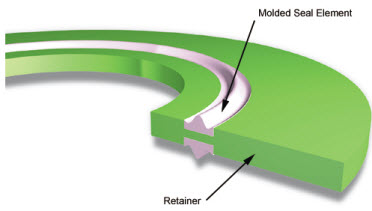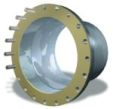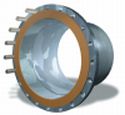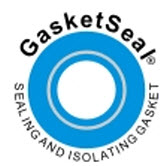1550 Cobb Industrial Dr. | P.O. Box 9098 | Marietta, GA 30065-2098
770-425-1355 (Phone) | 770-425-1354 (Fax) | info@alliedcorrosion.com (Email)
©2018 Allied Corrosion. All rights Reserved.
Made with ❤ by Mighty Good Marketing
Selected:

GasketSeal® sealing gaskets are considered to be one of the most effective methods for sealing mating surfaces of all types. The gasket consists of two molded half “O” rings (with precise crown to void ratio) mounted in grooves on opposite sides of a retainer.
While maintaining all the advantages of a full “O” ring seal, the half “O” rings eliminate the need for sealing grooves in the mating surfaces which also eliminates positioning and alignment concerns. GasketSeal® gaskets are available in a wide variety of retainer and sealing element combinations for matching gaskets to service and environmental conditions.
| Metal Retainer Materials |
Insulating Retainer Materials |
Sealing Elements |
||
|---|---|---|---|---|
| Aluminum | Ceramic | Buna-N(Nitrile) | ||
| Brass | Epoxy Glass | Buna-S | ||
| Carpenter 20 | Glass | Butyl | ||
| Carbon Steel | Lucite | EPDM | ||
| Cast Iron | Melamine | Hypolon | ||
| Clad Steel Materials | Phenolic | Kel-F | ||
| Copper | Polyester Glass | Natural Rubbers | ||
| Ductile Iron | Polyethylene | Neoprene | ||
| Hastelloy B | Polyphenol Ether | Nylon | ||
| Hastelloy C | Pyrox | Polimide | ||
| Hastelloy X | Silicone Glass | Polyurethane | ||
| Inconel X | Vinl | Silicone Rubber | ||
| Monel | Teflon® | |||
| Nickel 200 | Vinyl | |||
| Soft Iron | Viton® | |||
| Stainless Steel | ||||
| Tantalum | ||||
| Tin | ||||
| Titanium | ||||
| Vanadium |
Before TighteningThe flange faces come into contact with the crown of the sealing elements. As the flange is tightened the crowns are compressed into the molded-in voids in the sealing elements, resulting in a seal that will maintain positive, dynamic contact against the flange faces under all conditions. |
 |
After TighteningThe flange faces have come into firm contact with the retainer, thus encapsulating the sealing elements within grooves and guarding them from exposure to external environments or internal media. At the same time, the elastic memory characteristics of the confined sealing elements results in zero “”m”” and “”y”” factors, making it possible to effect and maintain a positive seal at the lowest possible compressive load. |
 |
 |
 |
The gasket retainer extends out to the O.D. of the flange. Holes are cut in a type “E” gasket at the bolt circle to accommodate threaded studs or bolts. |
The gasket retainer extends out to the I.D. of the bolt circle. |

| Medium | Retainer | Seal | Temp. Range °F | Temp. Range °C |
|---|---|---|---|---|
| Acetone | Phenolic | EPDM | +32 to +80 | 0 to +27 |
| Air | G-10 | Nitrile | -65 to +225 | -54 to +107 |
| Carbon Dioxide | G-10 | Nitrile | +32 to +150 | 0 to +66 |
| Ethanol | G-10 | EPDM | +32 to +100 | 0 to +38 |
| Fuel Oil | G-10 | Viton | -20 to +280 | -29 to +138 |
| Gas, Natural | Phenolic | Nitrile | -40 to +220 | -40 to +104 |
| Gas, Sour | Phenolic | Viton | -20 to +220 | -29 to +104 |
| Hydrogen | G-10 | Nitrile | -40 to +250 | -40 to +121 |
| Jet Fuel | G-10 | Viton | -20 to +225 | -29 to +107 |
| Nitrogen | Phenolic | Nitrile | -40 to +220 | -40 to +104 |
| Oil, Crude | G-10 | Viton | -20 to +280 | -29 to +138 |
| Propane | G-10 | Nitrile or Teflon | +32 to +80 | 0 to +27 |
| Propylene | G-10 | Viton | +32 to +80 | 0 to +27 |
| Sewage | G-10 | Viton | -20 to +280 | -29 to +138 |
| Tolulene | G-10 | Viton or Teflon | +32 to +150 | 0 to +66 |
| Water (Hot) | G-10 | EPDM | +175 to +280 | +79 to +138 |
| Water (Potable) | G-10 | EPDM | +32 to +280 | 0 to +138 |
| Water (Sea) | G-10 | EPDM | +32 to +280 | 0 to +138 |
| General Notes: The foregoing performance data are intended as guidelines only. Performance suitability for any specific applications should be determined by the user. Variation in temperature, pressure, concentration or mixtures acting synergistically may preclude suggested service use. Material selection is at the sole risk of the user. Consult with a specialist or PSI factory for specific applications. PSI’s responsibilities will be limited to those listed in the PSI standard warranties. |
||||
| Metal Retainers: GasketSeal® gaskets are available with a wide range of metal retainers to offer compatibility with flange metals, for extremely hazardous fluids or for extremes in temperatures and pressures. |
||||
| Nitrile | Vitron® | Teflon® | Neoprene | EPDM | |
|---|---|---|---|---|---|
| Degrees Farenheit | -40 to +250 | -20 to +350 | Cryogenic to +450 | -40 to +175 | -65 to +300 |
| Degrees Celsius | -40 to +121 | -29 to +177 | Cryogenic to +232 | -40 to +79 | -54 to +149 |
| Cryogenic Note: Consult with a specialist for cryogenic applications and/or extreme temperature variations, hazardous fluids or for extremes in temperatures and pressures. |
|||||
| ASTM | Test Method |
Plain Phenolic |
Rubber Faced Phenolic |
G-3 Hi-Temp Phenolic Glass |
G-7* Silicone Glass |
G-10 Epoxy Glass |
G-11 Epoxy Glass |
|---|---|---|---|---|---|---|---|
| D149 | Dielectric Strength Volts/Mil (Short Term) |
500 | 500 | 550 | 350 – 400 | 550 | 550 |
| D695 | Compressive Strength (psi) |
25,000 | 25,000 | 50,000 | 40,000 | 50,000 | 50,000+ |
| D229 | Water Absorption (percent) |
1.6 | 1.6 | 0.7 | 0.07 | 0.10 | 0.10 |
| D257 | Insulating Resistance Meg Ohms |
40,000 | 40,000 | 46,000 | 2,500 | 200,000 | 200,000 |
| D790 | Flexural Strength (psi) |
22,500 | 22,500 | 60,000 | 27,000 | 60,000 | 75,000+ |
| D785 | Harness Rockwell “M” |
85 | 85 | 115 | 105 | 115 | 115 |
| D256 | IZOD Impact Strength (Ft. Lbs./In.) |
1.2 | 1.2 | 112.0 | 8 | 14.0 | 12.0 |
| D638 | Tensile Strength (psi) |
20,000 | 20,000 | 42,000 | 25,000 | 45,000 | 43,000 |
| D732 | Shear Strength (psi) |
10,000 | 10,000 | 18,000 | 20,000 | 22,000 | 22,000 |
| Temperature Range Degrees Farenheit |
-65 to +220 | -65 to +175 | -65 to +392 | Cryogenic to +450 | Cryogenic to +280 | Cryogenic to +349 | |
| Temperature Range Degrees Celsius |
-54 to +104 | -54 to +79 | -54 to +200 | Cryogenic to +232 | Cryogenic to +138 | Cryogenic to +176 | |
| *G-7 Material should not be used with hydrocarbons, not even in trace amounts. | |||||||

To order LineBacker® Sealing/Isolating Gaskets please indicate the following:
Manufacturer’s warranty statement will be supplied upon request to Allied Corrosion Industries, Inc.
Materials for sealing gaskets on pipes containing water, aqueous fluids or natural gas (up to 221°F, 105°C) shall consist of the following components:
One full faced isolating and sealing gasket, GasketSeal® Type “E”, 1/8″ thick, phenolic retainer containing a precision tapered groove to accommodate the controlled compression of a nitrile sealing element. Sealing element placement shall accommodate either flat, raised or RTJ face flanges. The seal shall be pressure energized. The phenolic retainer shall have a 500 volts/mil dielectric strength and a minimum 25,000 psi compressive strength. The full faced flange isolating gasket shall be 1/8″ less in I.D. than the I.D. of the flange in which it is installed.
Gaskets shall be manufactured at a facility that has a registered ISO 9001:2000 Quality Management System. Submittals shall include copy of valid registration.
Gaskets shall be manufactured by Pipeline Seal and Insulator, Inc., Houston, Texas, U.S.A.,
Telephone: 713-747-6948
Facsimile: 713-747-6029
www.pipelineseal.com
e-mail: info@psipsi.com
Performance suitability and material compatibility shall be determined by the user.
Materials for sealing gaskets on pipes containing natural gas, oil and aqueous fluids (up to 280°F, 138°C) shall consist of the following components:
One full faced isolating and sealing gasket, GasketSeal® Type “E”, 1/8″ thick, G-10 retainer containing a groove to accommodate the controlled compression of a molded Viton sealing element. Sealing element placement shall accommodate either flat, raised face or RTJ flanges. The seal element seal shall be pressure energized. The G-10 retainer shall have a 550 volts/mil dielectric strength and a minimum 50,000 psi compressive strength. The full faced flange isolating gasket shall be 1/8″ less in I.D. than the I.D. of the flange in which it is installed.
Gaskets shall be manufactured at a facility that has a registered ISO 9001:2000 Quality Management System. Submittals shall include copy of valid registration.
Gaskets shall be manufactured by Pipeline Seal and Insulator, Inc., Houston, Texas, U.S.A.
Telephone: 713-747-6948
Facsimile: 713-747-6029
www.pipelineseal.com
e-mail: info@psipsi.com
Performance suitability and material compatibility shall be determined by the user.

1550 Cobb Industrial Dr. | P.O. Box 9098 | Marietta, GA 30065-2098
770-425-1355 (Phone) | 770-425-1354 (Fax) | info@alliedcorrosion.com (Email)
Made with ❤ by Mighty Good Marketing
We care about your privacy! In order to run a successful website, we are setting cookies and accessing and storing information on your device for various purposes. By continuing to browse this site, you are agreeing to our use of cookies.
If you wish to disable cookies, please visit our Privacy Policy for more information.
